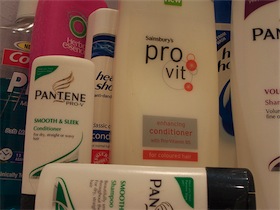 I’m going to tell you something you already know. You know it, but I’m going to tell you again, because you probably don’t do it.
I’m going to tell you something you already know. You know it, but I’m going to tell you again, because you probably don’t do it.
First, something to consider…
In our house, if you wander into the bathroom and poke your head behind the shower curtain. You will find quite a number of bottles crammed onto the tiny shelf. Including, not just one, but three separate bottles of shampoo. A white bottle with a blue lid for me, a tall architecturally designed cream bottle with a peach lid for my wife, and a transparent bottle of golden liquid for our kids.
Why the hell do we need three bottles of shampoo? They all do more or less exactly the same thing – clean hair.
We have them because shampoo companies know something. It’s the same thing that you already know.
You need to define your target market, and sell directly to them
Most small businesses, when asked who their target market is, have a version of the same answer.
“Anyone” or “Anyone with money”
The idea being that by targeting everybody, they have a larger potential market. Wrong! This strategy is leaving money on the table.
Back to shampoo… Do they sell less shampoo because one brand is targeted to only men? NO they sell more, a metric boatload more.
By targeting a specific, well defined market, it is easier to understand their problems and communicate how your product or service can solve it for them.
Everyone has hair that needs cleaning, but some have dry hair, oily hair, or an itchy scalp. Those are all specific problems that need solved.
Advertise specifically to your market
My shampoo says ‘for Men with sensitive scalps’. It’s a no brainer… That’s the stuff I need (or at least that I think I need).
By being specific you decommoditize your product or service. A product that fixes a specific issue is more valuable than a generic product.
But the market would be too small
Ok, here’s another example of a sneaky way to get around the problem with a small market. In the Internet marketing world, there is at least one dog training course that is marketed as train your Labrador, train your Great Dane, train your German shepherd and many other popular dog breeds.
It’s the same study course, the only way the course is differentiated is who it is marketed to (Labrador owners or German shepherd owners). Simple tactic but it works because all dog owners know their dog is the best dog breed, and training techniques tailored specifically to their breed is going to be better than general dog training.
Could you market the exact same product to two (or more) specific markets?
Action
Who can you help specifically? Write a list of specific groups of people who you could tailor your product or service to fix their specific problem.
Can you add something to you product or service to make it cater to a specific group?
How-to reports and Tips work great:
- ‘How to teach your child about bike safety’
- or ‘7 critical accounting systems for a new service business’
Try something to reach a niche market.
— Rinse and repeat —
photo credit: Cormac Heron
If you liked this post, we would really appreciate it if you could write a comment below or post it on Facebook. Sharing is what the cool kids are doing!
Oh, and jump over and ‘Like’ our Facebook page

